Abstract
Pre-coated metal sheets (PCM), as a popular product in modern coating industries, offer significant advantages such as simple processing, lightweight properties, and excellent manufacturability. The pretreatment layer within its coating system has a significant impact on overall corrosion resistance. In this study, through a comparative analysis of two chromate-free pretreatment systems, we conducted a thorough investigation into the combination of the pretreatment layer and examined the impact on the corrosion performance of pre-coated metal sheets. It was found that the phytic acid-based pretreatment layer enhances the adhesion between the primer and the substrate by forming strong chemical bonds with the primer layer, which effectively inhibits the lateral diffusion of corrosive media to the metal surface. Consequently, pre-coated metal sheets with the phytic acid-based pretreatment exhibit superior anti-foaming performance compared to the system using the silane-based pretreatment layer. This provides a new insight into the design and development of Cr-free pretreatment systems with better corrosion resistance performance.
1. Introduction
Coating protection is a widely adopted and highly effective method for extending the service life of components and structures [,,]. In the coating industry, the concept of “finish first, fabricate later” has been established for a long time, which refers to applying coatings prior to cutting metal sheets and assembling them into the final product []. Pre-coated metal sheets (PCM), as a typical representation of this concept, has been extensively utilized in applications such as building envelopes and household appliance housings due to its advantages of lightweight properties, weather resistance, and processability [,,]. The typical coating system of PCM consists of a metallic substrate, a metallic coating, a pretreatment layer (chemical conversion coating), a primer layer, and a topcoat layer [] providing long-term corrosion protection through a multi-layer barrier mechanism []. Among systems, the pretreatment layer plays a critical role in both processability and corrosion resistance [,].
Compared to chromate-free pretreatment systems, chromate-based systems (hexavalent chromium conversion coatings and chromate-containing primers) have dominated the market for decades due to the self-passivation effect of chromates. When the coating is damaged, chromate species can undergo redox reactions to dynamically form a Cr(OH)3/Cr2O3 composite passive film, effectively sealing scratches and suppressing the ingress of corrosive species, thereby delaying corrosion propagation and preventing blistering of the coating [,]. However, the high toxicity and carcinogenicity of hexavalent chromium compounds have raised severe environmental and health concerns, making the development of chromate-free technologies inevitable []. The evolution of chromium-free pretreatment technology from single- to multi-component systems has led to considerable improvements in corrosion resistance []. Nonetheless, the protective performance of these systems continues to lag considerably behind hexavalent chromium standards, primarily owing to the absence of self-healing functionality []. Adhesion, a critical performance parameter of coatings, plays a pivotal role in this regard. Improving adhesion not only facilitates the forming and processing of PCM but also effectively hinders the permeation and transport of corrosive media to the metal substrate, reducing coating blistering and delamination [,], thereby significantly improving overall corrosion performance. Noel Babu et al. []. reported that incorporating tannic acid grafted with allyl glycidyl ether into epoxy resin promotes the formation of secondary bonds (hydrogen bonds and van der Waals forces) at the coating–substrate interface, enhancing adhesion and improving coating durability. However, research on the electrochemical corrosion behavior and interfacial adhesion of intermediate layers in the coating system of PCM remains limited [].
Therefore, a systematic investigation of substrate pretreatment processes is essential to elucidate the impact of pretreatment adhesion strength and intrinsic protective ability on the overall corrosion resistance of PCM systems, thereby enabling the development of more efficient pretreatment technologies. It was found that, compared to the silane-based system with stronger inherent protective properties, the phytic acid pretreatment system forms more robust chemical bonding with the substrate and primer, significantly enhancing interlayer adhesion, thereby more effectively improving the overall corrosion resistance of the PCM.
2. Materials and Methods
2.1. Materials
The substrate used in this study was hot-dip galvanized steel (grade: DX51D+Z), provided by Pansteel Group Chengdu Plate Co., Ltd. (Chengdu, China). The commercial silane coupling agent-based commercial pretreatment solution (denoted as SCA), the commercial phytic acid-based pretreatment solution (denoted as PA), the commercial polyester primer, and polyester topcoat were supplied by Chengdu Hongding Technology Painting Co., Ltd. (Chengdu, China).
2.2. Coating Preparation
Prior to coating, the galvanized substrates were cut into 210 mm⋅300 mm panels, degreased using a commercial degreasing agent, rinsed three times with deionized water, and dried in the air. Coatings were applied using a doctor blade method. The thickness of the pretreatment layer was controlled to be less than 1 μm, while the primer and the topcoat layers were applied orderly at 5 ± 1 μm and 20 ± 3 μm. Specifically, a No. 3 wire-wound rod was used to evenly spread the pretreatment solution onto the substrate, followed by curing in an oven at a panel temperature of 120 °C for 15 s. After cooling, a No. 5 wire-wound rod was used to apply the primer, which was then baked at 216 °C for 30 s. Following a second cooling step, a No. 18 wire-wound rod was used to apply the topcoat, which was baked at 232 °C for 60 s. The coated samples were aged for 24 h and then cut into 75 mm × 150 mm panels for subsequent characterization.
2.3. Methodology
A scanning electron microscope (SEM, Zeiss Sigma 300, Oberkochen, Germany) was used to observe the surface and cross-sectional morphology of each coating. X-ray photoelectron spectroscopy (XPS, Thermo Fisher Nexsa, Waltham, MA, USA) was employed to analyze the chemical composition of the pretreatment layers and to investigate their film-forming mechanisms. Fourier-transform infrared spectroscopy (FT-IR, Thermo Nicolet iS5, Waltham, MA, USA) was used to assess the chemical composition at different regions of the sample.
A confocal laser scanning microscope (CLSM, Olympus LEXT OLS5000, Tokyo, Japan) was used to examine the surface morphology and measure the roughness of the substrates and coatings. After drying the sample surfaces with ethanol, three random positions were selected for analysis, and roughness parameters were evaluated using LEXT version 3.1.7.14 software.
The interfacial adhesion between the pretreatment layer and the primer was measured using a digital pull-off adhesion tester (Kezhirui SM-16, Kezhirui Electronics (Suzhou) Co., Ltd., Suzhou, China). Aluminum dollies with a diameter of 20 mm were cleaned and bonded vertically onto the coating surface using 3M DP420 adhesive (3M Company, St. Paul, MN, USA). Excess adhesive was carefully removed, and the samples were left to cure for 48 h. The cured interface was then cut circumferentially through the coating layers down to the substrate. A tensile load was applied at a constant rate of 0.3 MPa/s until failure occurred. Failure surfaces were visually inspected to determine the failure mode, which was classified according to EN ISO 4624:2003 []. Adhesive failure between the primer and pretreatment layer was recorded as “adhesive failure”, while failure within the adhesive or the primer itself was recorded as “cohesive failure”.
Electrochemical measurements including polarization curves and electrochemical impedance spectroscopy (EIS) were conducted using a PARSTAT302N workstation (Metrohm Corporation, Herisau, Switzerland) to evaluate the surface condition and corrosion protection ability of the pretreatment layer. A 3.5 wt% NaCl aqueous solution was used as the electrolyte. A three-electrode system was employed with a platinum mesh as the counter electrode, a saturated calomel electrode (SCE) as the reference electrode, and a 1 cm2 area of the coated sample as the working electrode. Polarization curves were recorded at a scan rate of 0.1 mV/s within a potential window of −0.24 to +0.24 V versus open circuit potential (OCP). For EIS, measurements were performed at different immersion times over a frequency range of 100 kHz to 10 mHz with an AC amplitude of 10 mV. The data were fitted using Nova 2.1 software. In the fitting circuit diagram, Rs represents the solution resistance, Ccoat the coating capacitance, Rcoat the coating resistance, Cdl the double-layer capacitance, and Rct the charge transfer resistance.
Two diagonal scratches forming a cross (scratch width 200 ± 5 µm) were made on the coating surface using a surgical blade, exposing the underlying galvanized layer. The edges of the sample were sealed with tape. The samples were then placed in a salt spray chamber (Q-FOG SSP1100, Q-Lab Corporation, Westlake, OH, USA) containing a 5 wt% NaCl solution at an inclination of 15–25° to the horizontal. Samples were removed at intervals and photographed using a digital camera to monitor corrosion progression. Triplicate samples were used for each condition to ensure reproducibility.
3. Results
3.1. Surface Characterization
The surface morphology of galvanized steel before and after pretreatment was characterized by SEM was used to observe the surface morphology SEM, with results shown in Figure 1. The untreated galvanized surface was uneven and exhibited numerous pits. Due to the poor film-forming ability of the XSL pretreatment, the pretreatment solution tended to accumulate in these pits. Upon high-temperature curing, cracks formed in the accumulated regions, while the raised areas were uniformly coated and crack-free. Conversely, the DY pretreatment solution exhibited no aggregation or cracking, indicating better film formation. Moreover, DY-treated surfaces showed increased roughness both at the pits and around the raised features, likely due to interfacial reactions between the pretreatment solution and the galvanized layer. This surface roughening is expected to enhance mechanical interlocking between the substrate and subsequent coating layers [].

Figure 1.
(a) SEM image of hot-dip galvanized surface without pretreatment, (b) after SXL-100P pretreatment, (c) after DY-PV0455 pretreatment.
3.2. Anti-Salt-Spray Performance of Coatings
Neutral salt spray (NSS) testing was conducted to evaluate the long-term corrosion resistance of coatings treated with different pretreatment solutions and to determine their effects on the overall corrosion protection of PCM. Figure 2 presents the salt spray testing results of the PCM with different pretreatment. After 120 h, both types of pretreated coated panels exhibited blistering at the scribed areas due to corrosion. After 480 h of exposure, blister size increased on both panels. However, the blisters on the SCA-pretreated panel were larger (a diameter of ~4 mm) and more numerous than those on the PA-treated panel (a diameter of ~3.5 mm), suggesting that the PA-pretreat system provides better long-term corrosion resistance.
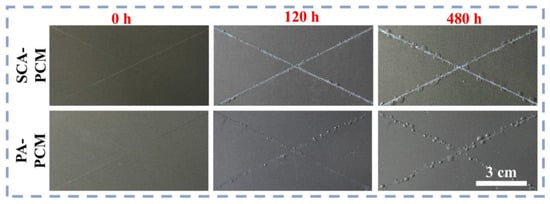
Figure 2.
Neutral salt spray testing results of the PCM with different pretreatment.
To evaluate the superior NSS resistance of PCM with PA-pretreat system, a comparative NSS testing was performed on different pretreatment layers. Figure 3 presents the salt spray testing results of different pre-treatment layers, after 120 h of exposure, both the uncoated galvanized panel and the panel pretreated with the PA solution exhibited extensive formation of white and yellow–brown corrosion products. In contrast, the panel treated with the SCA-pretreat showed a corrosion area of less than 5%, indicating that SCA-pretreatment layer offers superior self-protection.
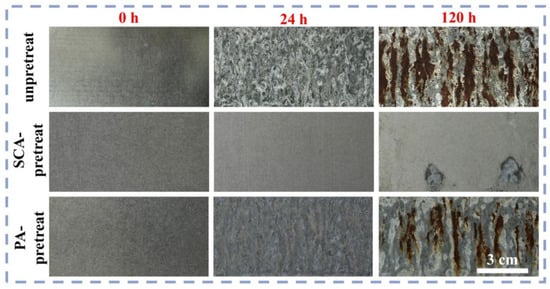
Figure 3.
Neutral salt spray testing results of different pretreatment metal sheets.
3.3. Corrosion Performance
To further assess the corrosion resistance of the two pretreatment systems, electrochemical impedance spectroscopy (EIS) and polarization measurements were performed in 3.5 wt% NaCl solution.
Figure 4 and Table 1 show the polarization curves and fitting parameters of galvanized steel under different pretreatment conditions. After PA pretreatment, the corrosion current density decreased from 3.74 × 10−6 A·cm−2 to 1.17 × 10−6 A·cm−2. In comparison, the SCA-pretreated sample exhibited a more significant reduction in corrosion current, down to 6.54 × 10−3 A·cm−2. Moreover, the corrosion potentials of both samples shifted in the positive direction, indicating improved resistance to anodic dissolution [].
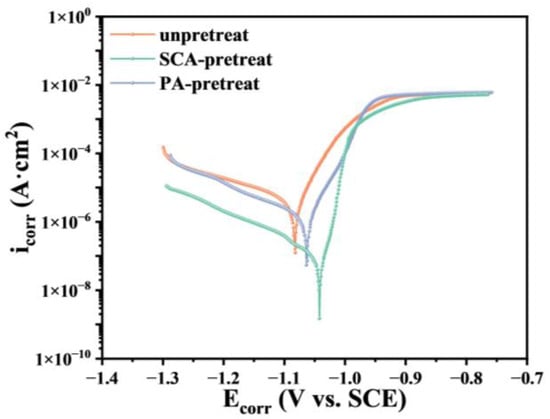
Figure 4.
Polarization curves of hot-dip galvanized steel with different pretreatment processes and without pretreatment.

Table 1.
Fitted polarization parameters of hot-dip galvanized steel with different pretreatments and without pretreatment.
The Nyquist and Bode diagrams and the electrochemical impedance fitting parameters are shown in Figure 5a,b and Table 2. The PA-pretreated substrate exhibits only one capacitive arc in both the Nyquist and Bode plots, which was fitted using a one-time-constant equivalent circuit model (Figure 5c). The impedance magnitude increased moderately, with the coating resistance (Rcoat) rising from 5.78 × 103 Ω·cm2 to 1.87 × 104 Ω·cm2, indicating the formation of a relatively dense and defect-free pretreatment layer with improved corrosion resistance [].
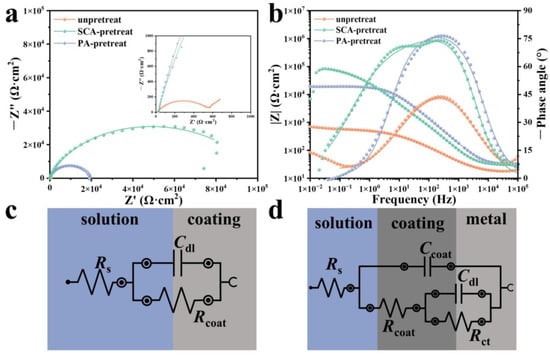
Figure 5.
EIS plots of hot-dip galvanized steel with different pretreatments and without pretreatment: (a) Nyquist plots, (b) Bode plots, (c) equivalent circuit model with a single time constant, and (d) equivalent circuit model with two times constants.

Table 2.
Fitted electrochemical impedance parameters of hot-dip galvanized steel with different pretreatments and without pretreatment.
In contrast, the SCA-pretreated substrate displayed an additional capacitive arc in the EIS spectra, necessitating a two-time-constant equivalent circuit model for fitting (Figure 5d). Although this suggests the possible presence of defects such as micro-cracks or grooves, the total resistance (Rcoat + Rct) increased significantly to 1.05 × 105 Ω·cm2, nearly an order of magnitude higher than that of the PA-pretreated sample. This demonstrates a substantial overall improvement in corrosion resistance despite the localized structural imperfections [].
4. Discussion
Despite the lower initial corrosion current of the SCA-pretreated system (Figure 4), the PCM of the PA pre-treated system demonstrates superior long-term anti-blistering performance (Figure 1) [].
To evaluate the effect of pretreatment on primer–substrate adhesion, interfacial adhesion strength was measured for three types of samples (Figure 6). Both the degreased galvanized steel and the SCA-pretreated sample exhibited adhesive failure, with adhesion strengths of 2.60 MPa and 5.50 MPa, respectively, indicating limited though improved interfacial bonding. In contrast, the PA-pretreated sample failed cohesively with a strength of 33.02 MPa, suggesting that the actual adhesion between the primer and substrate exceeds this value. This represents a substantial enhancement in bonding performance compared to the other samples [].
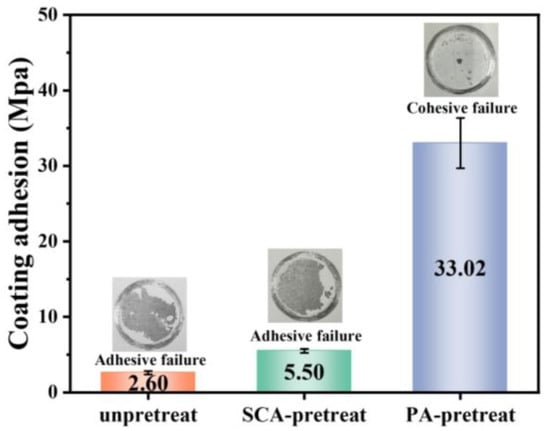
Figure 6.
Pull-off adhesion strength of hot-dip galvanized steel with different pretreatments and without pretreatment.
These findings demonstrate that improving the corrosion resistance of PCM relies not only on the self-protective capacity of the pretreatment layer, but more critically on superior interfacial adhesion between the pretreatment and primer layers, which effectively suppresses blistering [,]. Therefore, this paper examines the film-forming mechanism of the PA-pretreated layer and its bonding behavior with the primer, aiming to elucidate the origin of its superior adhesion.
4.1. Cross-Sectional Analysis
Figure 7 presents the cross-sectional image of the PCM panel treated with PA-pretreat. It shows well-defined interfaces between the layers, with no obvious defects or delamination. The hot-dip galvanized surface appears rough and uneven, which is beneficial for mechanical interlocking between the primer and the metallic coating [,]. The pretreatment layer is relatively thin, making it difficult to directly evaluate its effect on substrate roughness from the cross-section alone.

Figure 7.
SEM image of the PCM sheet’s cross-sectional after PA-pretreat.
4.2. Effect of Pretreatment on Surface State and Adhesion Strength
To gain deeper insight into the effect of PA-pretreat on the surface characteristics of the galvanized substrate and its role in improving adhesion, the surface morphology and roughness were examined via LSCM before and after treatment. LSCM analysis was employed to characterize the surface morphology and roughness of galvanized substrates before and after pretreatment, elucidating the reason for how the PA-pretreatment modifies surfaces and contributes to enhanced adhesion.
Figure 8a,b show the LSCM and contact angle measurements for the galvanized substrate before and after PA-pretreat, respectively. After pretreatment, the maximum surface roughness (Rz) decreased by 0.82 μm, while the local average roughness (Ra) in concave regions increased by nearly 60%. Simultaneously, the water contact angle decreased from 62° to 38°, indicating an increase in surface hydrophilicity. This behavior contrasts with the Wenzel model [], which states that for hydrophilic surfaces, a decrease in roughness typically reduces wettability, while for hydrophobic surfaces, wettability increases. The observed increase in hydrophilicity despite smoother surfaces suggests that PA-pretreat not only enhances mechanical interlocking but also introduces surface chemical groups capable of forming hydrogen bonds with the primer, thereby improving interfacial adhesion [].
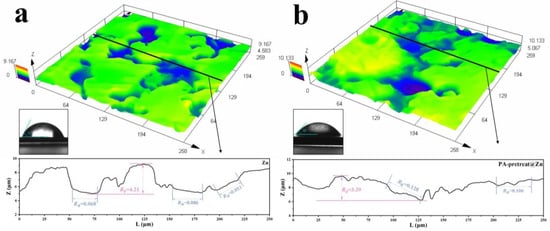
Figure 8.
SLCM and contact angle images of the surface before and after PA-pretreat: (a) without pretreatment, (b) with PA-pretreat.
4.3. Mechanism of Film Formation in Pretreatment Layer
To elucidate the mechanism of film formation and the potential reasons behind the enhanced adhesion between the pretreatment layer and the substrate, XPS analysis was conducted on both the freeze-dried solid phase of the pretreatment solution and the pretreated galvanized surface.
Figure 9a presents the wide-scan XPS spectra, indicating the presence of C, O, F, P, Ti, and Mn in the pretreatment solution. Figure 9b and Table 3 show the high-resolution c1s spectra and the contents of each component, with binding energy peaks corresponding to C–C and C–O bonds in both samples. The relative peak areas are summarized in Table 3. The O 1s spectra and the contents of each component (Figure 9c, Table 4) reveal peaks corresponding to P–O, C–O, and P–O bonds, with the P–O bond accounting for up to 65% of the total O species, confirming the presence of phytic acid in the pretreatment formulation []. On the pretreated galvanized surface, a peak at 530.5 eV corresponding to M–O bond was observed. The high-resolution Zn 2p spectra (Figure 9d) show two peaks at binding energies of 1021.5 eV (Zn 2p3/2) and 1044.5 eV (Zn 2p1/2), characteristic of Zn–O bonding, indicating that the high protonation ability of phytic acid reacts with galvanized layer and its surface oxides to form Zn2+ and forming P-O-Zn bonds between the pretreatment layer and the zinc coating. Figure 9e and Table 5 show the high-resolution Ti 2p spectra and the contents of each component. In the pretreatment agent, only TiF62− was detected with peaks at 460.1 eV (Ti 2p3/2) and 466.1 eV (Ti 2p1/2). After pretreatment, three species of Ti were observed: Ti(OH)2 (458.4 eV and 464.4 eV), TiO2 (456.5 eV and 463.0 eV), and residual TiF62−. Among them, Ti(OH)2 accounted for 51.9%, TiF62− for 40.6%, and TiO2 only 7.5%, suggesting that TiF62− partially decomposed during curing to form Ti(OH)2 and TiO2 [].
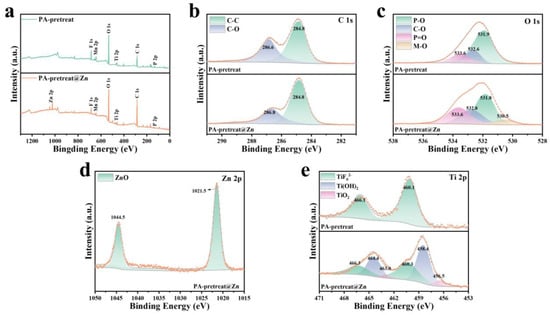
Figure 9.
XPS spectra of PA-pretreat solution and the hot-dip galvanized surface after PA-pretreat: (a) survey spectrum, (b) C 1s, (c) O 1s, (d) Zn 2p, and (e) Ti 2p.

Table 3.
Relative percentages of different C 1s chemical states in PA-pretreat solution and on the hot-dip galvanized steel surface.

Table 4.
Relative percentages of different O 1s chemical states in PA-pretreat solution and on the hot-dip galvanized steel surface.

Table 5.
Relative percentages of different Ti 2p chemical states in PA-pretreat solution and on the hot-dip galvanized steel surface.
4.4. Interfacial Bonding Mechanism Between Pretreatment and Primer Layers
To verify the formation of chemical bonding at the interface between the pretreatment layer and the primer, FTIR analysis was performed on three regions: (i) the pretreated galvanized steel surface, (ii) the primer/pretreatment interface, and (iii) the primer surface.
As shown in Figure 10, the pretreatment layer exhibited characteristic absorption peaks at 570 cm−1 (P–O), 1081 cm−1 (P–O–C), 1262 cm−1 (P=O), and 3383 cm−1 (O–H), corresponding to functional groups from phytic acid. The primer exhibited peaks at 1100 cm−1 (C–O–C), 1722 cm−1 (C=O), and 2927 cm−1 (C–H), typical of polyester resins []. At the interface, spectral features from both the pretreatment and primer layers were present. Notably, the P–O–C peak intensified while the P–OH peak diminished, indicating that P–OH groups from phytic acid reacted with unreacted –COOH groups in the polyester to form P–O–C linkages. This confirms that covalent bonding occurred at the interface []. The O–H absorption band at 3387 cm−1 did not show a red shift, suggesting that hydrogen bonding was weak and that the enhanced adhesion primarily stemmed from chemical (covalent) bonding rather than secondary interactions [].
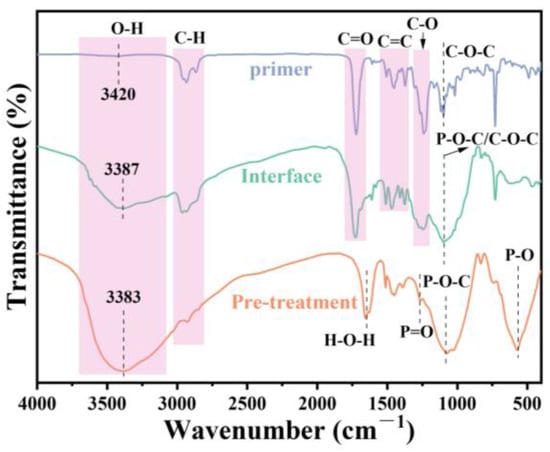
Figure 10.
FTIR spectra of different locations within the coating of PCM sheets after PA-pretreat.
5. Conclusions
This study demonstrates, through comparison of two pretreatment systems with distinct mechanisms, that enhancing the corrosion resistance of PCM depends both on improving the self-protective capacity of the pretreatment layer and on strengthening the interfacial adhesion between the pretreatment layer and the primer. Improved interfacial bonding can effectively suppress corrosion-induced blistering in pre-coated panels. Furthermore, this work elucidates the underlying mechanism by which the pretreatment enhances interfacial adhesion. Specifically, the PA-pretreated substrate exhibits not only increased surface roughness, promoting mechanical interlocking, but also an altered surface chemical state characterized by newly introduced functional groups. These groups form covalent bonds with the polyester primer, further enhancing the interfacial adhesion strength.
Author Contributions
Conceptualization, C.L. and X.D.; methodology, C.L.; software, J.Y.; validation, J.Y.; formal analysis J.Y.; investigation, L.L.; resources, L.L. and J.Y.; data curation, C.L.; writing—original draft preparation, C.L.; writing—review and editing, L.L.; visualization, X.D.; supervision, L.L.; project administration, X.D.; funding acquisition, L.L. All authors have read and agreed to the published version of the manuscript. All authors have read and agreed to the published version of the manuscript.
Funding
This research was funded by Pansteel Group Panzhihua Iron & Steel Research Institute Co., Ltd., grant number 24H0262 and the Science and Technology Planning Project of Sichuan, grant number 2023YFG0248.
Data Availability Statement
The original contributions presented in this study are included in the article. Further inquiries can be directed to the corresponding authors.
Acknowledgments
Thanks to Yanping Huang at the Center of Engineering Experimental Teaching, School of Chemical Engineering, Sichuan University, for assisting with the SEM measurements. Thanks to Mingyang Han, Shuyuan Zhai, Qin Long at School of Chemical Engineering, Sichuan University, and Chenyang Liao at Department of Materials, Imperial College London, for assisting with experiment.
Conflicts of Interest
Author Xueqiang Dong was employed by the company Pansteel Group Research Institute Co., Ltd. The authors declare that this study received funding from Pansteel Group Panzhihua Iron & Steel Research Institute Co., Ltd. The funder was not involved in the study design, collection, analysis, interpretation of data, the writing of this article or the decision to submit it for publication. The remaining authors declare that the research was conducted in the absence of any commercial or financial relationships that could be construed as a potential conflict of interest.
References
- Ma, Q.; Yang, Q.; Zhang, J.; Ren, F.; Xia, C.; Chen, F. Anti-corrosion properties of bio-inspired surfaces: A systematic review of recent research developments. Mater. Adv. 2024, 5, 2689–2718. [Google Scholar] [CrossRef]
- Sun, H.; Song, B.; Sun, X.; Cui, X.; Liu, Z.; Cong, M.; Sun, M.; Zhu, Z.; Tian, Y.; Liu, S.; et al. Recent Representative Progress of Surface Coating Technology. Chem. Rec. 2025, 25, e202500054. [Google Scholar] [CrossRef] [PubMed]
- Asim, N.; Badiei, M.; Samsudin, N.A.; Mohammad, M.; Razali, H.; Soltani, S.; Amin, N. Application of graphene-based materials in developing sustainable infrastructure: An overview. Compos. Part. B 2022, 245, 110188. [Google Scholar] [CrossRef]
- Yimyai, T.; Crespy, D.; Rohwerder, M. Corrosion-Responsive Self-Healing Coatings. Adv. Mater. 2023, 35, 2300101. [Google Scholar] [CrossRef]
- Lin, W.; Zhao, Y.; Edwards, G.; Guo, Q.; Chen, T.; Song, S.; Heitzmann, M.; Martin, D.; Grøndahl, L.; Lu, M.; et al. Mechanical properties and scratch recovery of nanoclay/polyester composite coatings for pre-coated metal (PCM) sheets. Compos. Part. B 2024, 273, 111217. [Google Scholar] [CrossRef]
- Ueda, K.; Kanai, H.; Amari, T. Formability of polyester/melamine pre-painted steel sheets from rheological aspect. Prog. Org. Coat. 2002, 45, 267–272. [Google Scholar] [CrossRef]
- Golgoon, A.; Aliofkhazraei, M.; Toorani, M.; Moradi, M.H.; Sabour Rouhaghdam, A. Corrosion and wear behavior of alumina-polyester nanocomposite coatings. Polym. Eng. Sci. 2017, 57, 846–856. [Google Scholar] [CrossRef]
- Moon, J.-I.; Lee, Y.-H.; Kim, H.-J. Synthesis and characterization of flexible polyester coatings for automotive pre-coated metal. Prog. Org. Coat. 2012, 73, 123–128. [Google Scholar] [CrossRef]
- Palraj, S.; Selvaraj, M.; Jayakrishnan, P. Effect of phosphate coatings on the performance of epoxy polyamide red oxide primer on galvanized steel. Prog. Org. Coat. 2005, 54, 5–9. [Google Scholar] [CrossRef]
- LeBozec, N.; Picot, P.; LeGac, A.; Thierry, D. Influence of Surface Preparation on the Durability of Repair Coatings for Prepainted Galvanised Steel. Mater. Corros. 2025, 76, 533–541. [Google Scholar] [CrossRef]
- Xing, T.; Ying, L.; Wu, C.; Fu, Z.; Wang, G. Study on the effect of surface tannic acid/silane conversion film on properties of epoxy resin coatings. Anti-Corros. Methods Mater. 2019, 66, 446–453. [Google Scholar] [CrossRef]
- Pan, J.; Tang, X.; Li, Y. Pulse potential method-assisted construction and regulation of a trivalent chromium conversion coating on hot-dip coated steel sheet. Corros. Sci. 2020, 176, 109026. [Google Scholar] [CrossRef]
- Hesamedini, S.; Bund, A. Trivalent chromium conversion coatings. J. Coat. Technol. Res. 2019, 16, 623–641. [Google Scholar] [CrossRef]
- Hesamedini, S.; Bund, A. Formation of Cr(VI) in cobalt containing Cr(III)-based treatment solution. Surf. Coat. Technol. 2018, 334, 444–449. [Google Scholar] [CrossRef]
- Peltier, F.; Thierry, D. Review of Cr-Free Coatings for the Corrosion Protection of Aluminum Aerospace Alloys. Coatings 2022, 12, 518. [Google Scholar] [CrossRef]
- He, W.; Xia, X.; Gao, X.; Yan, R.; Wang, Y.; Ma, H. Corrosion resistance and adhesive performance of a novel phytic acid-triethoxyvinylsilane-zinc hybrid chemical conversion film on steel. Int. J. Adhes. Adhes. 2023, 125, 103430. [Google Scholar] [CrossRef]
- Luo, X.; Li, Y.; Li, S.; Liu, X. Enhancement of Mechanical Properties and Bonding Properties of Flake-Zinc-Powder-Modified Epoxy Resin Composites. Polymers 2022, 14, 5323. [Google Scholar] [CrossRef]
- Awad, K.; Young, S.; Aswath, P.; Varanasi, V. Interfacial adhesion and surface bioactivity of anodized titanium modified with SiON and SiONP surface coatings. Surf. Interfaces 2022, 28, 101645. [Google Scholar] [CrossRef]
- Babu, N.; Zhang, P.; Xian, G. Improving epoxy adhesion with steel adherends using a tannic acid-based additive: Impact on resin properties and interfacial bonding. J. Appl. Polym. Sci. 2023, 140, e53803. [Google Scholar] [CrossRef]
- Chen, Q.; Zhang, Z.; Qi, Y. Effect of Composite Epoxy Coating on Protective and Bonding Properties to Nickel Aluminum Bronze. Adv. Eng. Mater. 2023, 25, 2201326. [Google Scholar] [CrossRef]
- BS EN ISO 4624:2003; Paints and Varnishes Pull-Off Test for Adhesion. British Standards Institution: London, UK, 2003.
- Kwon, D.-J.; Kim, J.-H.; Kim, Y.-J.; Kim, J.-J.; Park, S.-M.; Kwon, I.-J.; Shin, P.-S.; DeVries, L.K.; Park, J.-M. Comparison of interfacial adhesion of hybrid materials of aluminum/carbon fiber reinforced epoxy composites with different surface roughness. Compos. Part. B 2019, 170, 11–18. [Google Scholar] [CrossRef]
- Liu, Q.; Zhang, X.; Zhou, W.; Ma, R.; Du, A.; Fan, Y.; Zhao, X.; Cao, X. Improved anti-corrosion behaviour of an inorganic passive film on hot-dip galvanised steel by modified graphene oxide incorporation. Corros. Sci. 2020, 174, 108846. [Google Scholar] [CrossRef]
- Gao, F.; Du, A.; Ma, R.; Lv, C.; Yang, H.; Fan, Y.; Zhao, X.; Wu, J.; Cao, X. Improved corrosion resistance of acrylic coatings prepared with modified MoS2 nanosheets. Colloids Surf. Physicochem. Eng. Asp. 2020, 587, 124318. [Google Scholar] [CrossRef]
- Gou, J.; Wang, G.; Ning, Y.; Guan, L.; Zhang, Y.; Liao, J.; Wang, Y. Preparation and corrosion resistance of chromium-free Zn-Al coatings with two different silane coupling agents. Surf. Coat. Technol. 2019, 366, 1–6. [Google Scholar] [CrossRef]
- Rudawska, A.; Gola, A.; Pizoń, J.; Capała, P.; Wójcik, Ł. Effectiveness of Bonding Steel Elements with Polyester-Coated Paint. Appl. Sci. 2023, 13, 10059. [Google Scholar] [CrossRef]
- Joo, J.; Kang, M.; Moon, H.-S.; Wooh, S.; Lee, J. Design and experimental studies of self-healable anti-corrosion coating: Passivation of metal surfaces by silicone oil impregnated porous oxides. Surf. Coat. Technol. 2020, 404, 126595. [Google Scholar] [CrossRef]
- Yeadon, K.; Lai, E.P.C.; Huang, X.; Song, N. Influence of surface roughness and metal oxide nanoparticles on airframe with icephobic coatings. RSC Appl. Interfaces 2025, 2, 82–93. [Google Scholar] [CrossRef]
- Zhang, Q.; Yu, M.; Zhang, B.; Li, H. Effect of surface roughness of electroplating chromium coated steel on bonding strength of polymer coated steel. Polym. Polym. Compos. 2022, 30, 09673911221102128. [Google Scholar] [CrossRef]
- Duan, W.; Fan, Y.; Shu, B.; Liu, Y.; Wan, Y.; Xiao, R.; Xu, J.; Qing, S.; Xiao, Q. The Formation of Phytic Acid–Silane Films on Cold-Rolled Steel and Corrosion Resistance. Metals 2024, 14, 326. [Google Scholar] [CrossRef]
- Banjo, N.; Sasaki, T.T.; Hono, K. Uniform formation of Ti-based conversion coatings on aluminum alloy surfaces by alkaline-acid etch treatment to improve organic coating properties. Appl. Surf. Sci. 2024, 661, 160005. [Google Scholar] [CrossRef]
- Weinert, M.; Gutmann, J.S.; Dornbusch, M. Hydrophobic phytic acid conversion layers for corrosion protection of steel surfaces. J. Coat. Technol. Res. 2024, 21, 703–736. [Google Scholar] [CrossRef]
- Asemani, H.R.; Ahmadi, P.; Sarabi, A.A.; Eivaz Mohammadloo, H. Effect of zirconium conversion coating: Adhesion and anti-corrosion properties of epoxy organic coating containing zinc aluminum polyphosphate (ZAPP) pigment on carbon mild steel. Prog. Org. Coat. 2016, 94, 18–27. [Google Scholar] [CrossRef]
Disclaimer/Publisher’s Note: The statements, opinions and data contained in all publications are solely those of the individual author(s) and contributor(s) and not of MDPI and/or the editor(s). MDPI and/or the editor(s) disclaim responsibility for any injury to people or property resulting from any ideas, methods, instructions or products referred to in the content. |
© 2025 by the authors. Licensee MDPI, Basel, Switzerland. This article is an open access article distributed under the terms and conditions of the Creative Commons Attribution (CC BY) license (https://creativecommons.org/licenses/by/4.0/).